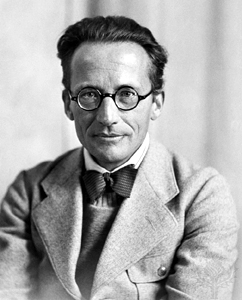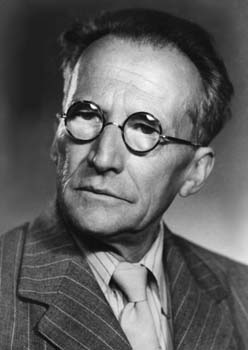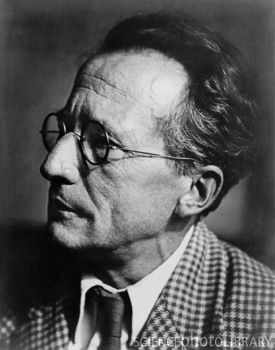<Back to Index>
- Physicist Erwin Rudolf Josef Alexander Schrödinger, 1887
PAGE SPONSOR



Erwin Rudolf Josef Alexander Schrödinger (12 August 1887 – 4 January 1961) was an Austrian born physicist and theoretical biologist who was one of the fathers of quantum mechanics, and is famed for a number of important contributions to physics, especially the Schrödinger equation, for which he received the Nobel Prize in Physics in 1933. In 1935 he proposed the Schrödinger's cat thought experiment.
In 1887 Schrödinger was born in Vienna, Austria to Rudolf Schrödinger (cerecloth producer, botanist) and Georgine Emilia Brenda (daughter of Alexander Bauer, Professor of Chemistry, Technische Hochschule Vienna).
His mother was half Austrian and half English; His father was Catholic and his mother was Lutheran. Despite having a religious background, he was later said to be an atheist.
In 1898 he attended the Akademisches Gymnasium. Between 1906 and 1910 Schrödinger studied in Vienna under Franz Serafin Exner (1849 – 1926) and Friedrich Hasenöhrl (1874 – 1915). He also conducted experimental work with Karl Wilhelm Friedrich "Fritz" Kohlrausch 1884 – 1953.
In 1911 Schrödinger became an assistant to Exner. At an early age,
Schrödinger was strongly influenced by Arthur Schopenhauer. As a result
of his extensive reading of Schopenhauer's works, he became
deeply interested throughout his life in color theory and philosophy.
In his lecture "Mind and Matter," he said that "the world extended in
space and time is but our representation." This is a repetition of the
first words of Schopenhauer's main work
In 1914 Erwin Schrödinger achieved Habilitation (venia legendi). Between 1914 and 1918 he participated in war work as a commissioned officer in the Austrian fortress artillery (Gorizia, Duino, Sistiana, Prosecco, Vienna). On 6 April 1920, Schrödinger married Annemarie Bertel. The same year, he became the assistant to Max Wien, in Jena, and in September 1920 he attained the position of ao. Prof. (Ausserordentlicher Professor), roughly equivalent to Reader (UK) or associate professor (US), in Stuttgart. In 1921, he became o. Prof. (Ordentlicher Professor, i.e., full professor), in Breslau (now Wrocław, Poland).
In 1921, he moved to the University of Zürich. In January 1926, Schrödinger published in Annalen der Physik the paper "Quantisierung als Eigenwertproblem" [tr. Quantization as an Eigenvalue Problem] on wave mechanics and what is now known as the Schrödinger equation. In this paper he gave a "derivation" of the wave equation for time independent systems, and showed that it gave the correct energy eigenvalues for the hydrogen like atom. This paper has been universally celebrated as one of the most important achievements of the twentieth century, and created a revolution in quantum mechanics, and indeed of all physics and chemistry. A second paper was submitted just four weeks later that solved the quantum harmonic oscillator, the rigid rotor and the diatomic molecule, and gives a new derivation of the Schrödinger equation. A third paper in May showed the equivalence of his approach to that of Heisenberg and gave the treatment of the Stark effect. A fourth paper in this most remarkable series showed how to treat problems in which the system changes with time, as in scattering problems. These papers were the central achievement of his career and were at once recognized as having great significance by the physics community.
In 1927, he succeeded Max Planck at the Friedrich Wilhelm University in Berlin. In 1933, however, Schrödinger decided to leave Germany; he disliked Nazis' anti - semitism. He became a Fellow of Magdalen College at the University of Oxford. Soon after he arrived, he received the Nobel Prize together with Paul Dirac. His position at Oxford did not work out; his unconventional personal life (Schrödinger lived with two women) was not met with acceptance. In 1934, Schrödinger lectured at Princeton University; he was offered a permanent position there, but did not accept it. Again, his wish to set up house with his wife and his mistress may have posed a problem. He had the prospect of a position at the University of Edinburgh but visa delays occurred, and in the end he took up a position at the University of Graz in Austria in 1936.
In the midst of these tenure issues in 1935, after extensive
correspondence with Albert Einstein, he proposed what is now called the
Schrödinger's cat thought experiment.
In 1939, after the Anschluss, Schrödinger had problems because of his flight from Germany in 1933 and his known opposition to Nazism. He issued a statement recanting this opposition (he later regretted doing so, and he personally apologized to Einstein). However, this did not fully appease the new dispensation and the university dismissed him from his job for political unreliability. He suffered harassment and received instructions not to leave the country, but he and his wife fled to Italy. From there he went to visiting positions in Oxford and Ghent Universities.
In 1940 he received a personal invitation from Ireland's Taoiseach Éamon de Valera to reside in Ireland and agree to help establish an Institute for Advanced Studies in Dublin. He moved to Clontarf, Dublin, and became the Director of the School for Theoretical Physics and remained there for 17 years, during which time he became a naturalized Irish citizen. He wrote about 50 further publications on various topics, including his explorations of unified field theory.
In 1944, he wrote What is Life?, which contains a discussion of negentropy and the concept of a complex molecule with the genetic code for living organisms. According to James D. Watson's memoir, DNA, the Secret of Life, Schrödinger's book gave Watson the inspiration to research the gene, which led to the discovery of the DNA double helix structure. Similarly, Francis Crick, in his autobiographical book What Mad Pursuit, described how he was influenced by Schrödinger's speculations about how genetic information might be stored in molecules. However, the geneticist and 1946 Nobel prize winner H.J. Muller had in his 1922 article "Variation due to Change in the Individual Gene" already laid out all the basic properties of the heredity molecule that Schrödinger derives from first principles in What is Life?, properties which Muller refined in his 1929 article "The Gene As The Basis of Life" and further clarified during the 1930s, long before the publication of What is Life?.
Schrödinger stayed in Dublin until retiring in 1955. During this time he remained committed to his particular passion; involvements with students occurred and he fathered two children by two different Irish women. He had a life long interest in the Vedanta philosophy of Hinduism, which influenced his speculations at the close of What is Life? about the possibility that individual consciousness is only a manifestation of a unitary consciousness pervading the universe. A manuscript "Fragment From An Unpublished Dialogue of Galileo" from this time recently resurfaced at The King's Hospital boarding school, Dublin, after it was written for the School's 1955 edition of their Blue Coat to celebrate his leaving of Dublin to take up his appointment as Chair of Physics at the University of Vienna.
In 1956, he returned to Vienna (chair ad personam). At an
important lecture during the World Energy Conference he refused to speak
on nuclear energy because of his skepticism about it and gave a
philosophical lecture instead. During this period Schrödinger turned
from mainstream quantum mechanics' definition of wave – particle duality
and promoted the wave idea alone, causing much controversy.
Schrödinger suffered from tuberculosis and several times in the 1920s stayed at a sanatorium in Arosa. It was there that he discovered his wave equation.
Schrödinger decided in 1933 that he could not live in a country in which persecution of Jews had become a national policy. Alexander Frederick Lindemann, the head of physics at Oxford University, visited Germany in the spring of 1933 to try to arrange positions in England for some young Jewish scientists from Germany. He spoke to Schrödinger about posts for one of his assistants and was surprised to discover that Schrödinger himself was interested in leaving Germany. Schrödinger asked for a colleague, Arthur March, to be offered a post as his assistant.
The request for March stemmed from Schrödinger's unconventional relationships with women: although his relations with his wife Anny were good, he had had many lovers with his wife's full knowledge (and in fact, Anny had her own lover, Hermann Weyl). Schrödinger asked for March to be his assistant because, at that time, he was in love with March's wife Hilde.
Many of the scientists who had left Germany spent mid 1933 in the Italian province of South Tyrol. Here Hilde became pregnant with Schrödinger's child. On 4 November 1933 Schrödinger, his wife and Hilde March arrived in Oxford. Schrödinger had been elected a fellow of Magdalen College. Soon after they arrived in Oxford, Schrödinger heard that, for his work on wave mechanics, he had been awarded the Nobel prize.
In early 1934 Schrödinger was invited to lecture at Princeton University and while there he was made an offer of a permanent position. On his return to Oxford he negotiated about salary and pension conditions at Princeton but in the end he did not accept. It is thought that the fact that he wished to live at Princeton with Anny and Hilde both sharing the upbringing f his child was not found acceptable. The fact that Schrödinger openly had two wives, even if one of them was married to another man, was not well received in Oxford either. Nevertheless, his daughter Ruth Georgie Erica was born there on 30 May 1934.
On 4 January 1961, Schrödinger died in Vienna
at the age of 73 of tuberculosis. He left a widow, Anny (born Annemarie
Bertel on 3 December 1896, died 3 October 1965), and was buried in Alpbach, Austria.
The philosophical issues raised by Schrödinger's cat are still
debated today and remains his most enduring legacy in popular science,
while Schrödinger's equation is his most enduring legacy at a more technical level. The huge crater Schrödinger, on the far side of the Moon, is named after him. The Erwin Schrödinger International Institute for Mathematical Physics was established in Vienna in 1993.
One of Schrödinger's lesser known areas of scientific contribution was his work on color, color perception, and colorimetry (Farbenmetrik). In 1920, he published three papers in this area:
- "Theorie der Pigmente von größter Leuchtkraft," Annalen der Physik, (4), 62, (1920), 603 - 622
- "Grundlinien einer Theorie der Farbenmetrik im Tagessehen," Annalen der Physik, (4), 63, (1920), 397 - 426; 427 - 456; 481 - 520 (Outline of a theory of color measurement for daylight vision)
- "Farbenmetrik," Zeitschrift für Physik, 1, (1920), 459 - 466 (Color measurement).
The second of these is available in English as "Outline of a Theory of Color Measurement for Daylight Vision" in Sources of Color Science, Ed. David L. MacAdam, The MIT Press (1970), 134 - 182.